warning light Lancia Ypsilon 2002 Owner handbook (in English)
[x] Cancel search | Manufacturer: LANCIA, Model Year: 2002, Model line: Ypsilon, Model: Lancia Ypsilon 2002Pages: 191, PDF Size: 2.45 MB
Page 13 of 191
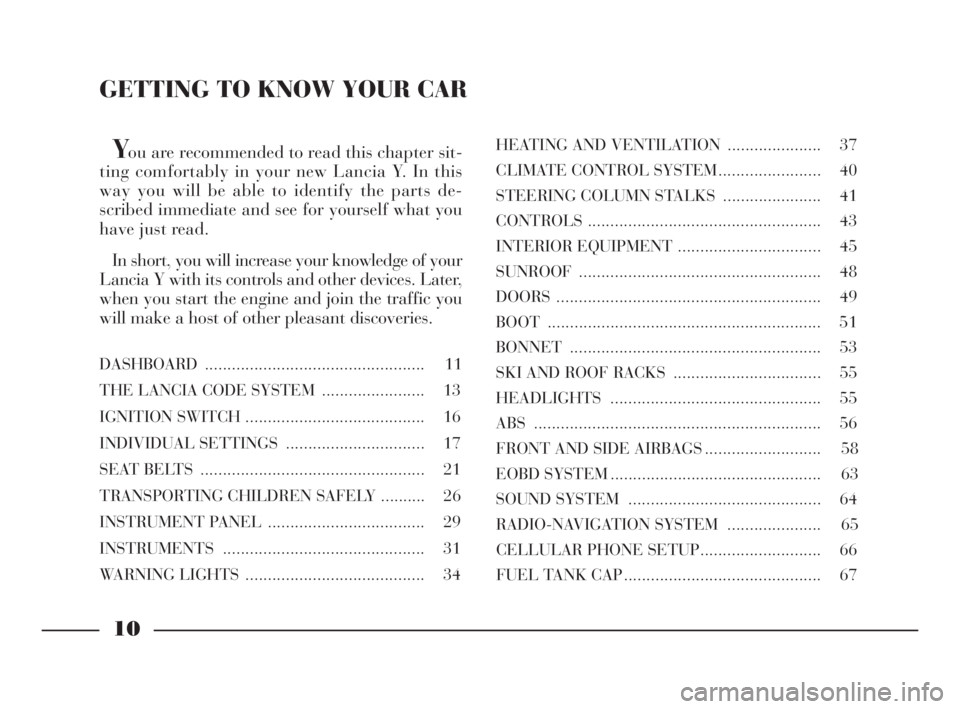
You are recommended to read this chapter sit-
ting comfortably in your new Lancia Y. In this
way you will be able to identify the parts de-
scribed immediate and see for yourself what you
have just read.
In short, you will increase your knowledge of your
Lancia Y with its controls and other devices. Later,
when you start the engine and join the traffic you
will make a host of other pleasant discoveries.
DASHBOARD................................................. 11
THE LANCIA CODE SYSTEM....................... 13
IGNITION SWITCH ........................................ 16
INDIVIDUAL SETTINGS ............................... 17
SEAT BELTS .................................................. 21
TRANSPORTING CHILDREN SAFELY .......... 26
INSTRUMENT PANEL ................................... 29
INSTRUMENTS............................................. 31
WARNING LIGHTS ........................................ 34HEATING AND VENTILATION ..................... 37
CLIMATE CONTROL SYSTEM....................... 40
STEERING COLUMN STALKS ...................... 41
CONTROLS.................................................... 43
INTERIOR EQUIPMENT ................................ 45
SUNROOF...................................................... 48
DOORS........................................................... 49
BOOT ............................................................. 51
BONNET........................................................ 53
SKI AND ROOF RACKS................................. 55
HEADLIGHTS............................................... 55
ABS ................................................................ 56
FRONT AND SIDE AIRBAGS.......................... 58
EOBD SYSTEM............................................... 63
SOUND SYSTEM ........................................... 64
RADIO-NAVIGATION SYSTEM..................... 65
CELLULAR PHONE SETUP........................... 66
FUEL TANK CAP ............................................ 67
10
G
GETTING TO KNOW YOUR CAR
4C001-067 ING 11-03-2008 11:57 Pagina 10
Page 14 of 191
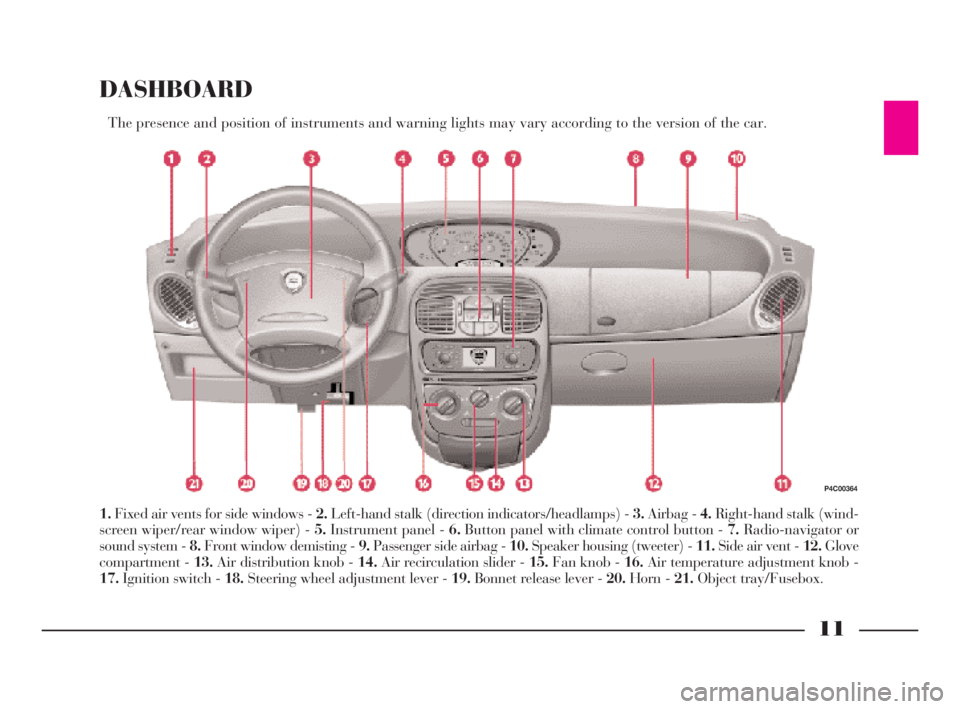
11
G
DASHBOARD
The presence and position of instruments and warning lights may vary according to the version of the car.
1.Fixed air vents for side windows - 2.Left-hand stalk (direction indicators/headlamps) - 3.Airbag - 4.Right-hand stalk (wind-
screen wiper/rear window wiper) - 5.Instrument panel - 6.Button panel with climate control button - 7.Radio-navigator or
sound system - 8.Front window demisting - 9.Passenger side airbag - 10.Speaker housing (tweeter) - 11.Side air vent - 12.Glove
compartment - 13.Air distribution knob - 14.Air recirculation slider - 15.Fan knob - 16.Air temperature adjustment knob -
17.Ignition switch - 18.Steering wheel adjustment lever - 19.Bonnet release lever - 20.Horn - 21.Object tray/Fusebox.
P4C00364
4C001-067 ING 11-03-2008 11:57 Pagina 11
Page 15 of 191
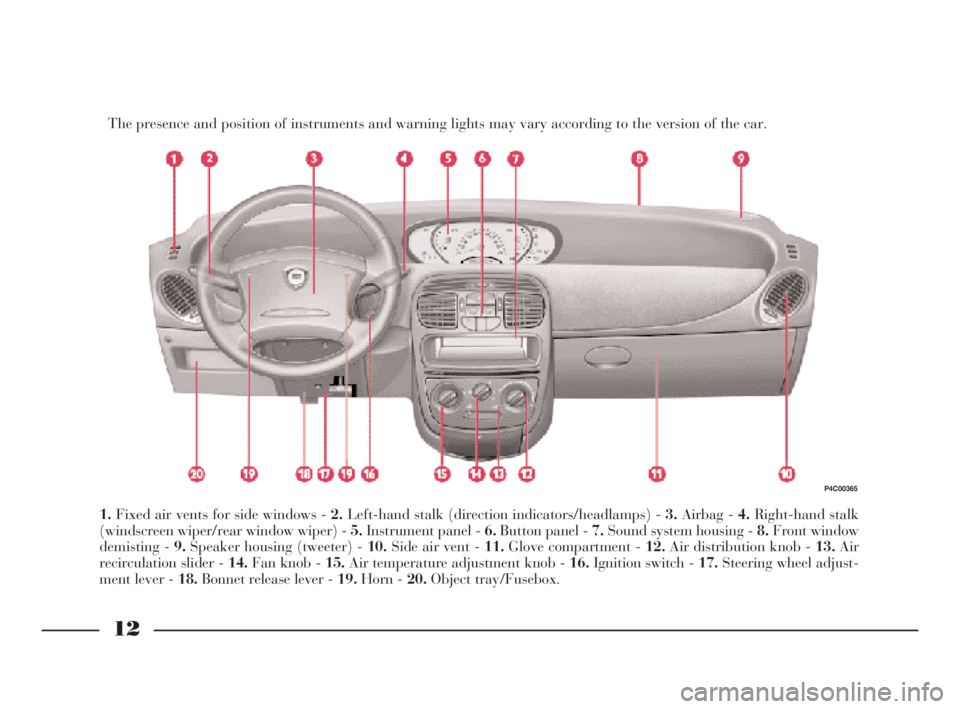
12
G
The presence and position of instruments and warning lights may vary according to the version of the car.
1.Fixed air vents for side windows - 2.Left-hand stalk (direction indicators/headlamps) - 3.Airbag - 4.Right-hand stalk
(windscreen wiper/rear window wiper) - 5.Instrument panel - 6.Button panel - 7.Sound system housing - 8.Front window
demisting - 9.Speaker housing (tweeter) - 10.Side air vent - 11.Glove compartment - 12.Air distribution knob - 13.Air
recirculation slider - 14.Fan knob - 15.Air temperature adjustment knob - 16.Ignition switch - 17.Steering wheel adjust-
ment lever - 18.Bonnet release lever - 19.Horn - 20.Object tray/Fusebox.
P4C00365
4C001-067 ING 11-03-2008 11:57 Pagina 12
Page 17 of 191
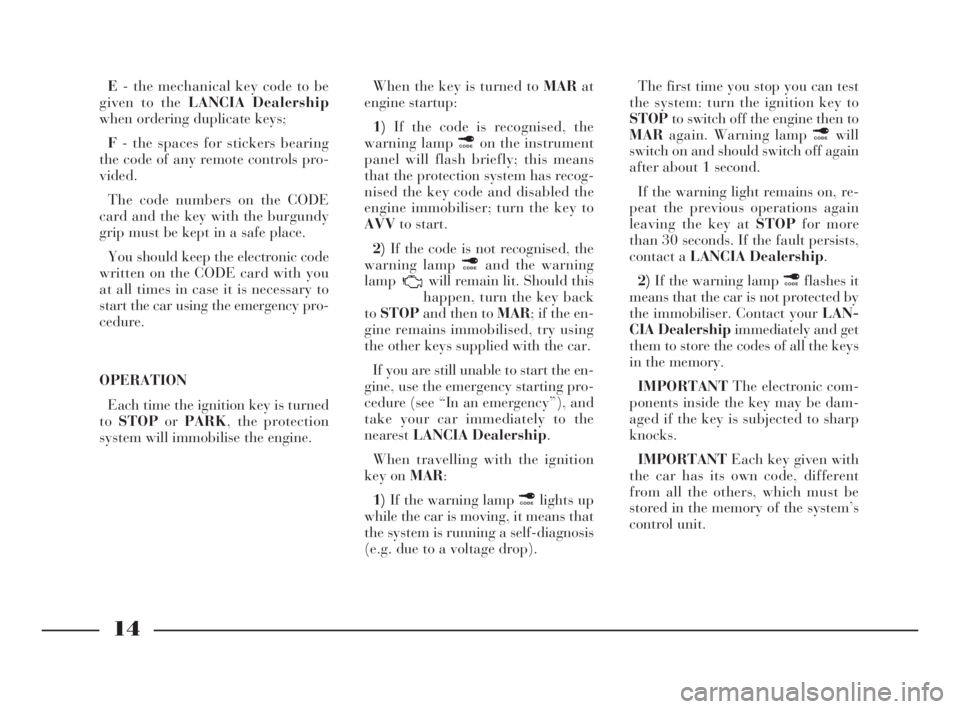
14
G
E- the mechanical key code to be
given to the LANCIA Dealership
when ordering duplicate keys;
F- the spaces for stickers bearing
the code of any remote controls pro-
vided.
The code numbers on the CODE
card and the key with the burgundy
grip must be kept in a safe place.
You should keep the electronic code
written on the CODE card with you
at all times in case it is necessary to
start the car using the emergency pro-
cedure.
OPERATION
Each time the ignition key is turned
toSTOPorPARK, the protection
system will immobilise the engine.When the key is turned to MARat
engine startup:
1)If the code is recognised, the
warning lamp ¢on the instrument
panel will flash briefly; this means
that the protection system has recog-
nised the key code and disabled the
engine immobiliser; turn the key to
AVVto start.
2)If the code is not recognised, the
warning lamp ¢and the warning
lamp will remain lit. Should this
happen, turn the key back
toSTOPand then to MAR; if the en-
gine remains immobilised, try using
the other keys supplied with the car.
If you are still unable to start the en-
gine, use the emergency starting pro-
cedure (see “In an emergency”), and
take your car immediately to the
nearestLANCIA Dealership.
When travelling with the ignition
key on MAR:
1)If the warning lamp ¢lights up
while the car is moving, it means that
the system is running a self-diagnosis
(e.g. due to a voltage drop). The first time you stop you can test
the system: turn the ignition key to
STOPto switch off the engine then to
MARagain. Warning lamp ¢will
switch on and should switch off again
after about 1 second.
If the warning light remains on, re-
peat the previous operations again
leaving the key at STOPfor more
than 30 seconds. If the fault persists,
contact a LANCIA Dealership.
2)If the warning lamp ¢flashes it
means that the car is not protected by
the immobiliser. Contact your LAN-
CIA Dealershipimmediately and get
them to store the codes of all the keys
in the memory.
IMPORTANTThe electronic com-
ponents inside the key may be dam-
aged if the key is subjected to sharp
knocks.
IMPORTANTEach key given with
the car has its own code, different
from all the others, which must be
stored in the memory of the system’s
control unit.
4C001-067 ING 11-03-2008 11:57 Pagina 14
Page 30 of 191
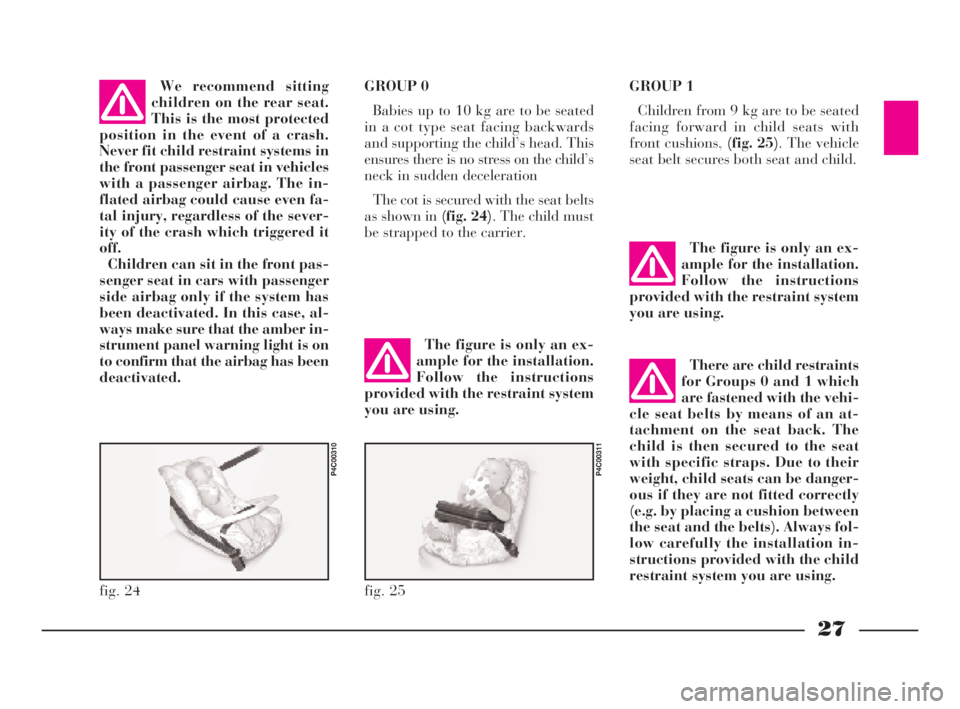
27
G
fig. 24
P4C00310
fig. 25
P4C00311
We recommend sitting
children on the rear seat.
This is the most protected
position in the event of a crash.
Never fit child restraint systems in
the front passenger seat in vehicles
with a passenger airbag. The in-
flated airbag could cause even fa-
tal injury, regardless of the sever-
ity of the crash which triggered it
off.
Children can sit in the front pas-
senger seat in cars with passenger
side airbag only if the system has
been deactivated. In this case, al-
ways make sure that the amber in-
strument panel warning light is on
to confirm that the airbag has been
deactivated.GROUP 0
Babies up to 10 kg are to be seated
in a cot type seat facing backwards
and supporting the child’s head. This
ensures there is no stress on the child’s
neck in sudden deceleration
The cot is secured with the seat belts
as shown in (fig. 24). The child must
be strapped to the carrier.GROUP 1
Children from 9 kg are to be seated
facing forward in child seats with
front cushions, (fig. 25). The vehicle
seat belt secures both seat and child.
The figure is only an ex-
ample for the installation.
Follow the instructions
provided with the restraint system
you are using.
The figure is only an ex-
ample for the installation.
Follow the instructions
provided with the restraint system
you are using.
There are child restraints
for Groups 0 and 1 which
are fastened with the vehi-
cle seat belts by means of an at-
tachment on the seat back. The
child is then secured to the seat
with specific straps. Due to their
weight, child seats can be danger-
ous if they are not fitted correctly
(e.g. by placing a cushion between
the seat and the belts). Always fol-
low carefully the installation in-
structions provided with the child
restraint system you are using.
4C001-067 ING 11-03-2008 11:57 Pagina 27
Page 31 of 191
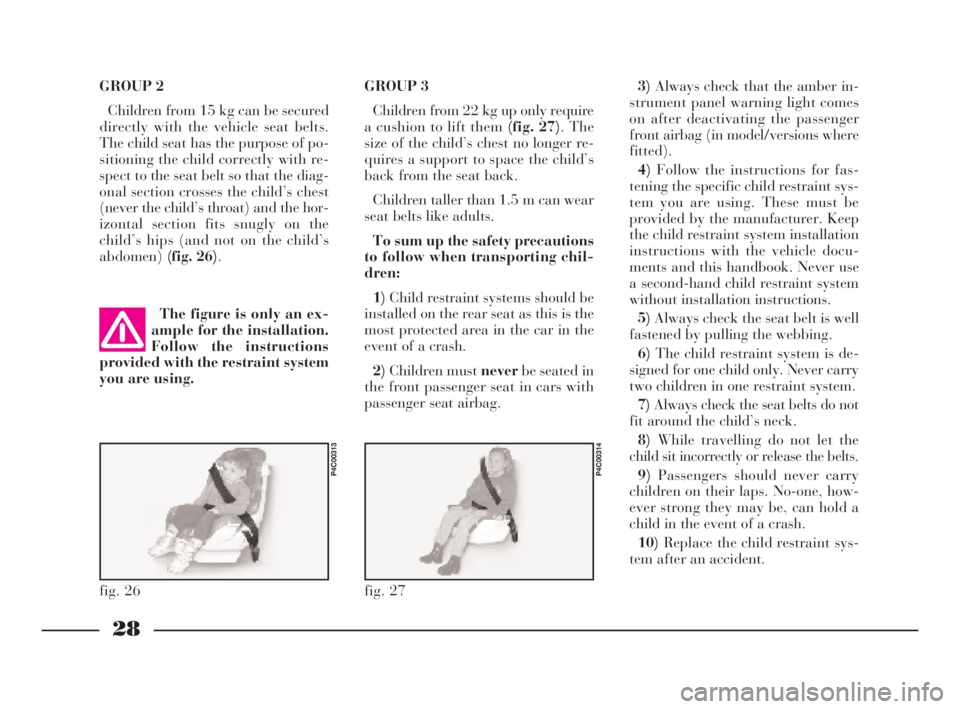
28
G
fig. 26
P4C00313
fig. 27
P4C00314
GROUP 2
Children from 15 kg can be secured
directly with the vehicle seat belts.
The child seat has the purpose of po-
sitioning the child correctly with re-
spect to the seat belt so that the diag-
onal section crosses the child’s chest
(never the child’s throat) and the hor-
izontal section fits snugly on the
child’s hips (and not on the child’s
abdomen)(fig. 26).GROUP 3
Children from 22 kg up only require
a cushion to lift them (fig. 27). The
size of the child’s chest no longer re-
quires a support to space the child’s
back from the seat back.
Children taller than 1.5 m can wear
seat belts like adults.
To sum up the safety precautions
to follow when transporting chil-
dren:
1)Child restraint systems should be
installed on the rear seat as this is the
most protected area in the car in the
event of a crash.
2)Children must neverbe seated in
the front passenger seat in cars with
passenger seat airbag.3)Always check that the amber in-
strument panel warning light comes
on after deactivating the passenger
front airbag (in model/versions where
fitted).
4)Follow the instructions for fas-
tening the specific child restraint sys-
tem you are using. These must be
provided by the manufacturer. Keep
the child restraint system installation
instructions with the vehicle docu-
ments and this handbook. Never use
a second-hand child restraint system
without installation instructions.
5)Always check the seat belt is well
fastened by pulling the webbing.
6)The child restraint system is de-
signed for one child only. Never carry
two children in one restraint system.
7)Always check the seat belts do not
fit around the child’s neck.
8)While travelling do not let the
child sit incorrectly or release the belts.
9)Passengers should never carry
children on their laps. No-one, how-
ever strong they may be, can hold a
child in the event of a crash.
10)Replace the child restraint sys-
tem after an accident. The figure is only an ex-
ample for the installation.
Follow the instructions
provided with the restraint system
you are using.
4C001-067 ING 11-03-2008 11:57 Pagina 28
Page 32 of 191
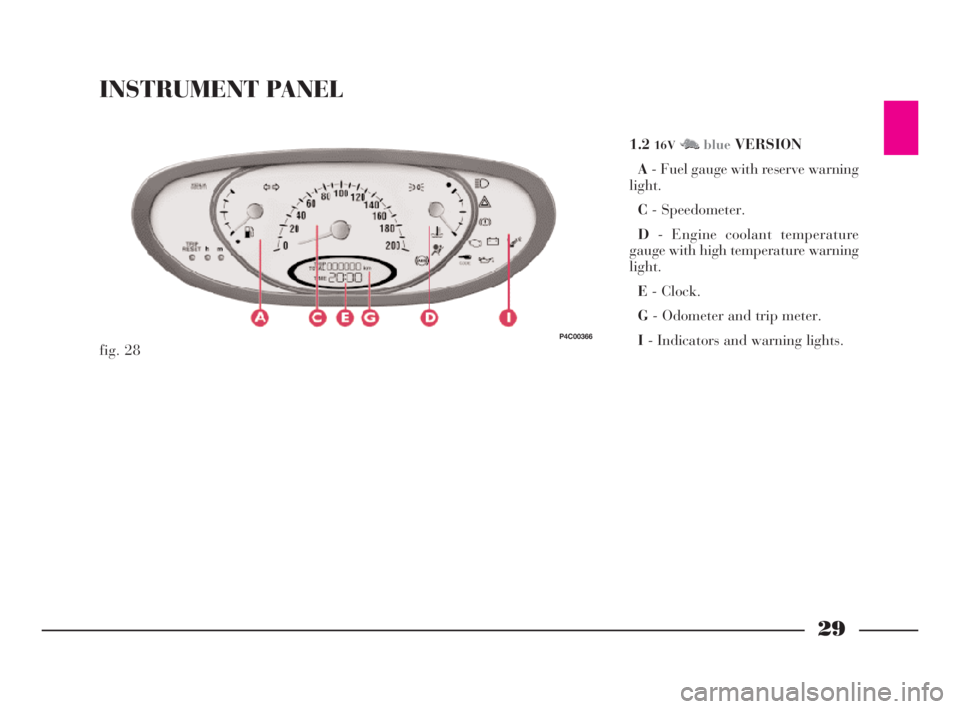
29
G
INSTRUMENT PANEL
1.216VM NblueVERSION
A- Fuel gauge with reserve warning
light.
C- Speedometer.
D- Engine coolant temperature
gauge with high temperature warning
light.
E- Clock.
G- Odometer and trip meter.
I- Indicators and warning lights.
fig. 28
P4C00366
4C001-067 ING 11-03-2008 11:57 Pagina 29
Page 33 of 191

30
G
LS-LX VERSIONS
A- Fuel gauge with reserve warning
light.
B- Rev counter.
C- Speedometer.
D- Engine coolant temperature gauge
with high temperature warning light.
E- Clock.
F- Outside temperature gauge.
G- Odometer.
H- Trip meter.
I- Indicators and warning lights.
fig. 29
P4C00367
1.216VM NredVERSION
A- Fuel gauge with reserve warning
light.
B- Rev counter.
C- Speedometer.
D- Engine coolant temperature gauge
with high temperature warning light.
E- Clock.
F- Outside temperature gauge.
G- Odometer.
H- Trip meter.
I- Indicators and warning lights.
fig. 30
P4C00368
4C001-067 ING 11-03-2008 11:57 Pagina 30
Page 34 of 191

31
G
INSTRUMENTS
SPEEDOMETER (fig. 31)ODOMETER AND TRIP
METER
For LS-LX - 1.216VM M Nredver-
sions(fig. 32)
A- Odometer.
B- Trip meter.
Press “Reset” button C (fig. 36)to
reset.
For the 1.2
16VM Nblueversion(fig.
33), only the odometer is displayed;
to display the trip meter, press button
C (fig. 36)slightly and release.
Press button C (fig. 36)for more
than 3 seconds to reset the trip
odometer.
Press button C (fig. 36) again to re-
turn to the odometer display.COOLANT TEMPERATURE
GAUGE (fig. 34)
If warning lamp Alights up, it
means that the engine coolant is too
hot.
Under normal conditions, the needle
of the temperature gauge should be-
tween 1/4 and 3/4 of the scale. If it
approaches the red section it means
the engine is being overtaxed and you
should reduce your demands on it.
IMPORTANTThe gauge will point
to low temperature and the excessive
temperature warning light Awill
come on to indicate a fault in the sys-
tem. Contact a LANCIA Dealership
to have the system checked.
fig. 32
P4C00370
fig. 33
P4C00371
fig. 31
P4C00369
fig. 34
P4C00372
4C001-067 ING 11-03-2008 11:57 Pagina 31
Page 35 of 191
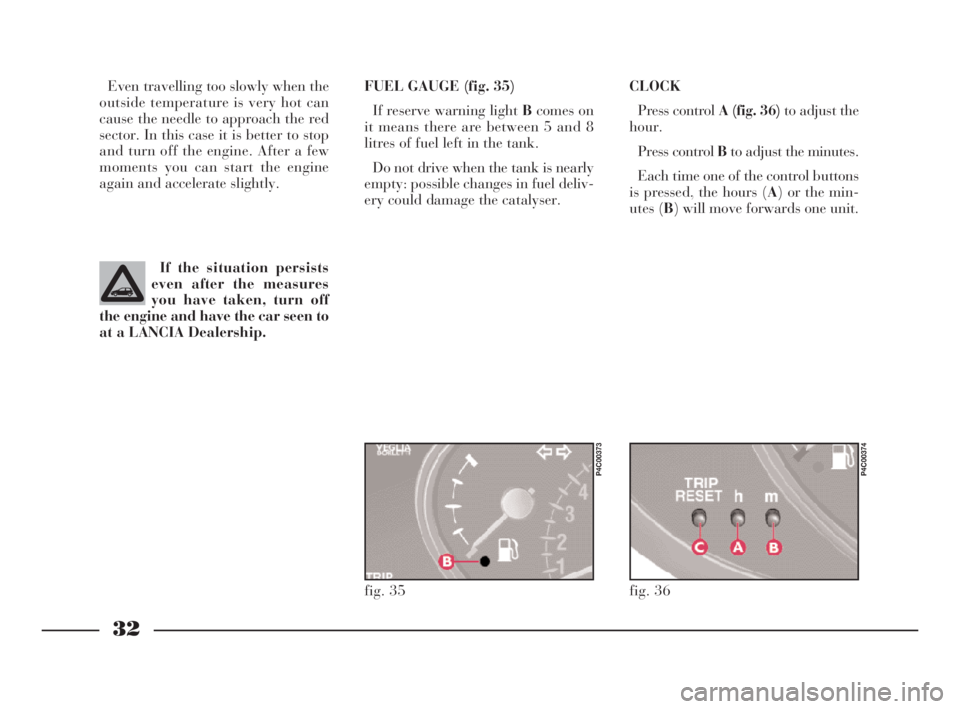
32
G
CLOCK
Press control A (fig. 36)to adjust the
hour.
Press control Bto adjust the minutes.
Each time one of the control buttons
is pressed, the hours (A) or the min-
utes (B) will move forwards one unit. Even travelling too slowly when the
outside temperature is very hot can
cause the needle to approach the red
sector. In this case it is better to stop
and turn off the engine. After a few
moments you can start the engine
again and accelerate slightly.FUEL GAUGE (fig. 35)
If reserve warning light Bcomes on
it means there are between 5 and 8
litres of fuel left in the tank.
Do not drive when the tank is nearly
empty: possible changes in fuel deliv-
ery could damage the catalyser.
If the situation persists
even after the measures
you have taken, turn off
the engine and have the car seen to
at a LANCIA Dealership.
fig. 36
P4C00374
fig. 35
P4C00373
4C001-067 ING 11-03-2008 11:57 Pagina 32